27 results
Biology cultural activities for Google Apps
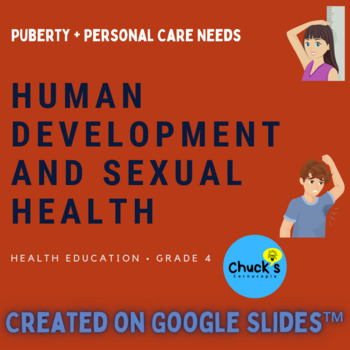
Online Health Human Development and Sexual Health for Grade 4 on Google Slides™
The focus of this resource is Puberty and Personal Care.***If you have any questions about the resources, whether prior to or after purchase, please feel free to contact me at chuck@chuckscornucopia.com. If you feel this resource is missing vital information, please email me and I will do my best to offer edits or add to the resource.***This resource, created on Google Slides™ for your Google Classroom™, is an interesting and detailed look into the grade 4 Ontario curriculum as it pertains to Hu
Subjects:
Grades:
4th - 6th

Leaf Collection Project -Native American Knowledge of Indigenous Plants
Background: Indigenous people have been using medicine harvested from various parts of plants since time immemorial. Aspirin, for example, is made from refined salicin. Salicin is found in nature in high abundance in willow bark, a medicine Native Americans traditionally chewed or brewed into teas for aches and pains. One would be hard-pressed to find an endemic plant in the United States that did not have some medicinal or cultural value to Indigenous people.Objective: By completing this projec
Subjects:
Grades:
7th - 12th, Higher Education, Adult Education
NGSS:
HS-LS2-5
, HS-ESS3-3
, HS-ESS3-1
, HS-LS4-3
![Preview of Kimchi Lab, Articles, & Lesson Plan: 9-12 [osmosis + cellular respiration]](https://ecdn.teacherspayteachers.com/thumbitem/Kimchi-Lab-Articles-Lesson-Plan-9-12-osmosis-cellular-respiration--8457124-1712141273/original-8457124-1.jpg)
Kimchi Lab, Articles, & Lesson Plan: 9-12 [osmosis + cellular respiration]
This material supplements our engaging Science Behind video about Kimchi where we explore the science of aerobic and anaerobic respiration (fermentation) through fermented cabbage, or kimchi. Students will learn about the stages of cellular aerobic respiration and anaerobic lactic acid fermentation by making a traditional Korean food, kimchi. The science in this unit is geared towards a high school understanding of the topic. NOTE: You do not have to do the lab. Students can still learn a lot by
Subjects:
Grades:
9th - 12th
NGSS:
HS-LS2-3
, HS-LS1-7
, HS-LS1-6
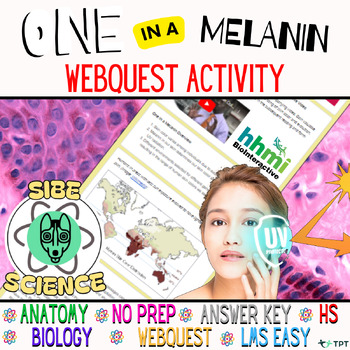
Biology Webquest | Melanin | Science | Multicultural | Google Forms | Anatomy, 9
✋️Introducing One In A Melanin: The Biology of Skin Color — HHMI BioInteractive Video Webquest, a comprehensive resource designed for grades 9-12. With a focus on inquiry-based learning, this resource encourages students to explore the biology of skin color dynamically and interactively. The resource includes a captivating reading passage, and an educational video component, and fosters thought-provoking discussions that will challenge your students' thinking. What sets this resource apart is it
Grades:
9th - 12th
Types:
NGSS:
HS-LS1-2
, HS-LS1-1
, HS-LS1-4
, HS-LS1-6
, HS-LS1-3
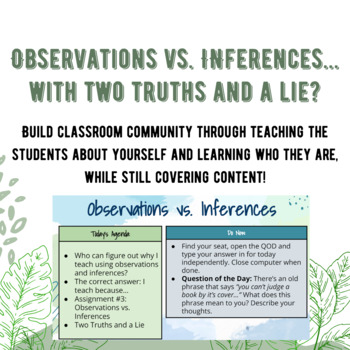
Observations vs. Inferences (with two truths and a lie!)
Lesson Overview: Oh, the power of observations and inferences - they are imperative to science! Not to mention that they are a great way to let your students get to know you, and a great way to get to know your new students. Observations and inferences can be taught by providing students with a small item that represents who you are or why you teach - ask them to observe and infer what that item means to you. For example, my students analyze one of my favorite pieces of wall art, a sketch of a h
Subjects:
Grades:
6th - 11th
Also included in: STRONG Start to the School Year in Biology BUNDLE!
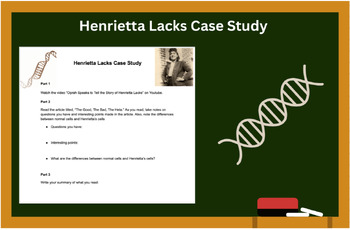
Henrietta Lacks Case Study
Easy to teach, fun to learn! This case study contains two guided readings (version 1 and version 2), differentiated based on reading levels. Students learn about one of the most important women in science, Henrietta Lacks, and create an argument for or against the use of tissue biopsy in science. This lesson is best placed at the end of a unit on DNA, mutations, and protein synthesis.
Grades:
8th - 10th
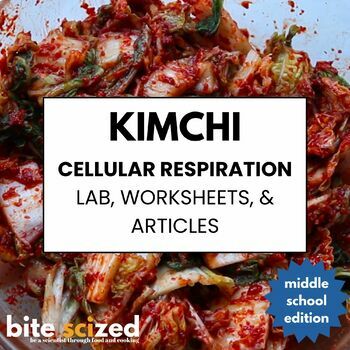
Explore Microbes, Cellular Respiration & Ecosystems through Kimchi Lab & Lesson
In this 4-6 day lesson, students explore microbes, cellular respiration, and environmental factors in ecosystems by making and observing kimchi over time.Essential Questions:What is kimchi and how is it made?How does kimchi change over time as it sits?How can we influence the growth of microbes [LAB] in kimchi?You can learn more details about the exact materials needed for this lesson and labs, as well as the timing of each lab, at our website: www.bitescized.org. Go to https://www.bitescized.or
Subjects:
Grades:
5th - 8th
NGSS:
MS-LS2-3
, MS-LS2-4
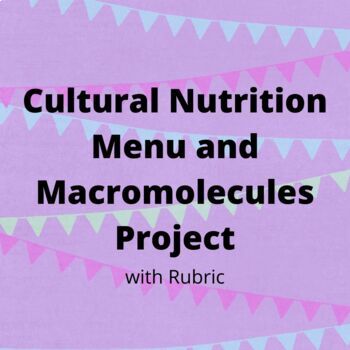
Cultural Nutrition Menu and Macromolecules Project with Rubric
Students will form an understanding of how the macromolecules are important to their diet by creating a menu from their culture or a combination of cultures within their group. This project is done as a follow up to learning the macromolecules and is intended to be used instead of a test.
Grades:
8th - 10th

Thanksgiving Meal Writing Prompt (Cellular Respiration)
Easy to teach, fun to learn! This writing prompt relates what students eat during a traditional Thanksgiving meal to how their body coverts that food into energy using cellular respiration. This assignment can be applied to any cultural holiday or food dish as well! Topics Covered: Cellular respiration is described in detailed steps from start to ATP production Steps include inputs and outputs of glycolysis, Krebs Cycle, Electron Transport ChainSteps include what happens without oxygen Law of Co
Subjects:
Grades:
8th - 10th
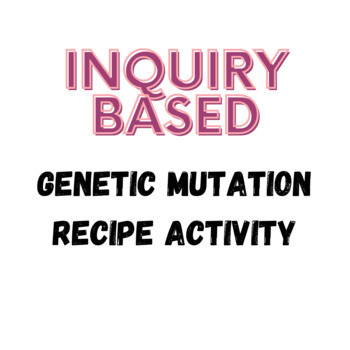
Genetic Mutation Recipe Activity
Teach genetic mutations using your students' favorite recipes! In this activity students choose their favorite recipe and explain one change that they could make to the recipe to make the final product better, the same, or worse. Students then respond to discussion questions that lead them to the conclusion that genetic mutations can be helpful, harmful, or neutral to the survival of an organism.This resource is designed to be done digitally. It can be completed synchronously or asynchronously w
Grades:
7th - 10th

Black History Month Activities for Biology, Chemistry or Any Science Class
This NO PREP Black History Month resource contains 4 Activities AND an informational packet on 12 African American Scientists. These activities will fit into ANY science curriculum, including Biology, Chemistry, Physics, Environmental Science, etc. NO PREP!! All activities can be completed using the informational packet. All activities and the informational packet are available in both Digital and Print optionsThe 4 EDITABLE Activities in this resource: (Digital and Print options for each)1.
Subjects:
Grades:
9th - 11th

Human Adaptations to Environments Slides
Discuss the diversity in the human race and the environmental factors that contribute to differences in human appearances globally with this lesson. These slides describe 5 specific examples of human adaptations to environments around the world, including:Skin ColorHigh ElevationsMalariaSub-Freezing TemperaturesBody Size and ShapeStructural/Physiological Adaptations vs. Behavioral Adaptations in humans is also covered.
Grades:
7th - 9th
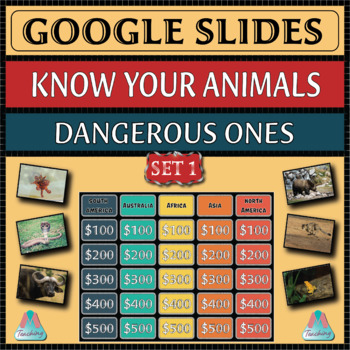
Animals Quiz - Dangerous Ones 1 (w/ Researchable Questions) Google Slides
Know Your Animals Quiz – Dangerous Ones Set 1 is a fun, general knowledge trivia quiz designed for use on Google Slides. Questions are based on 25 potentially dangerous animals in our wondrous world. The 5 categories are arranged by continents (Please note that Europe is omitted due to its comparatively safe animal world while Australia stands alone in representing the Oceania continent). South America AustraliaAfricaAsiaNorth AmericaThe dangerous animals included in Set 1:Jaguar, golden poison
Subjects:
Grades:
4th - 12th
Types:
Also included in: Animals Quiz - Dangerous Ones Bundle (w/ Researchable Questions): Slides
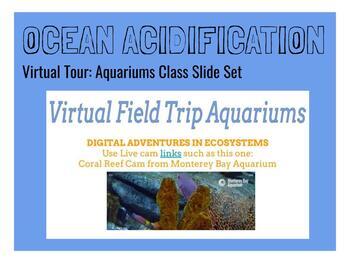
Ocean Acidification: Virtual Tour of Aquariums
This activity is one of the Explore options within the Ocean Acidification Project. It is a great way for students learning online about actual ecosystems in our aquariums, especially when it is not feasible to visit one in person.Use this class set of Google slides that has a background for each student slide as the tour observation work as students explore an ecosystem using Live Cams at aquariums around the United States.As students explore the aquariums live cams for as long as you assign th
Subjects:
Grades:
6th - 9th
Types:
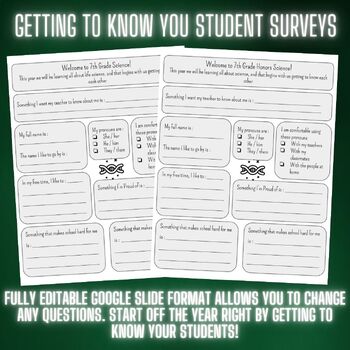
Getting to Know You Back to School Surveys for Science Class
Start off the year right by using these fully editable surveys to get to know your students!The surveys come pre-loaded with questions geared to start building relationships from day one. This resource is on Google Slides, so you can edit, add, or remove any questions to your liking. A back to school must have!
Subjects:
Grades:
5th - 12th
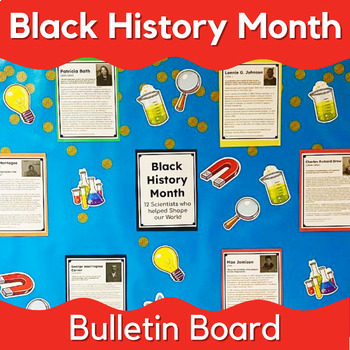
Black History Month Bulletin Board Decor - Poster Set for Any Science Class
This classroom decor set contains Posters featuring 12 African American scientists that can be printed and displayed to create a bulletin board or to decorate a classroom. These can be used in any science classroom: Biology, Chemistry, Physics, Earth Science, Ecology, Anatomy & Physiology, etc. This Product Contains 12 Posters of African American Scientists in TWO FORMATS: Black and White (printer friendly) and Color. How to Use this Product:1) Make a bulletin board using all 12 posters 2
Subjects:
Grades:
Not Grade Specific
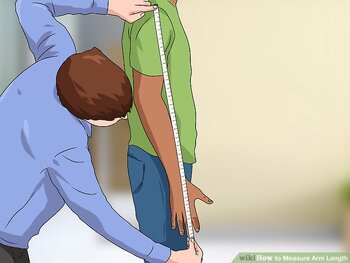
Height Estimation from Bone Length
This is an activity where students use tape measures to measure their height in cm. Then measure the length of their femur, humerus, and radius and use math and STEM skills to plug those measurements into formulas that are gender specific and racially specific as well to determine which of those bones provided the best estimation of their height.
Grades:
9th - 11th, Higher Education
CCSS:
NGSS:
HS-LS1-1
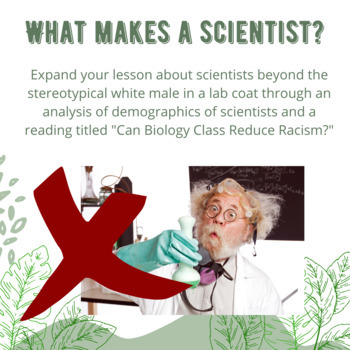
What makes a scientist?
Lesson Overview: The activity begins with Part One: Draw a Scientist, where each student will create and share a quick sketch of a scientist in action, followed by a class discussion around the images. Then, in Part Two: Analyzing data - who does biology? students will analyze several graphs and visualizations to see the diversity in biologists of both biological gender and race/ethnicity. Students will then begin Part Three: Can Biology Class Reduce Racism? And answer both reading questions and
Subjects:
Grades:
7th - 11th
Also included in: STRONG Start to the School Year in Biology BUNDLE!
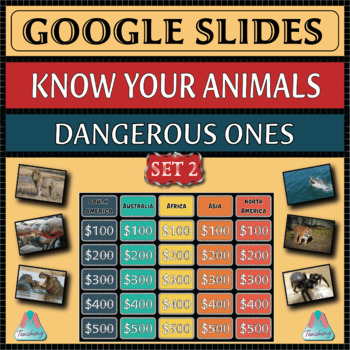
Animals Quiz - Dangerous Ones 2 (w/ Researchable Questions) Google Slides
Know Your Animals Quiz – Dangerous Ones Set 2 is a fun, general knowledge trivia quiz designed for use on Google Slides.Questions are based on 25 potentially dangerous animals in our wondrous world. The 5 categories are arranged by continents (please note that Europe is omitted due to its comparatively safe animal world, and Australia stands alone in representing the Oceania continent)South America AustraliaAfricaAsiaNorth AmericaThe dangerous animals included in Set 2:Brazilian wandering spider
Subjects:
Grades:
4th - 12th
Types:
Also included in: Animals Quiz - Dangerous Ones Bundle (w/ Researchable Questions): Slides
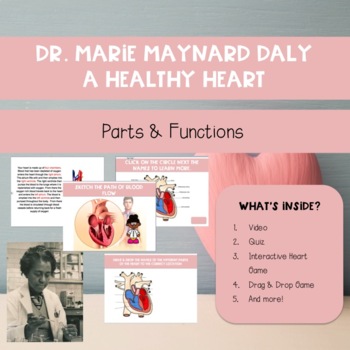
Heart Parts & Functions With Dr. Marie Maynard Daly
It's Black History Month, the second women of color in STEM I'd like to highlight is the biochemist Dr. Marie Maynard Daly. Dr. Marie Maynard Daly is known for her contribution towards hypertension. In this STEM activity for kids that honors women of color in STEM students will learn who Dr. Marie Maynard Daly is, play an interactive heart game and a drag and drop game. It is a virtual activity that can be used on Google Slides or Seesaw. In this activity you will find:Introduction to Marie Mayn
Subjects:
Grades:
6th - 8th
Types:
NGSS:
MS-LS1-3
Also included in: Women of Color in STEM Challenges
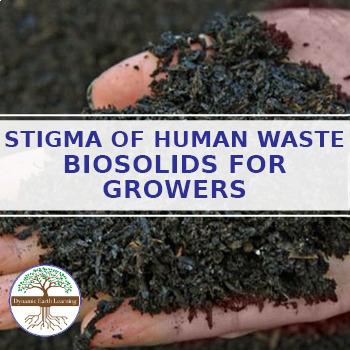
Stigma of Human Waste Biosolids for Growers - Science Worksheet Print or Google
In more and more places farmers are being urged to put aside their prejudices and consider an alternative to animal manure. The question is whether other fertilizers such as biosolids, also known as human waste, are a good option for soils.In this lesson, students will learn that biomass isn't just poo. It contains organic carbon, nitrogen, phosphorus, and trace elements and these are good for growing.Format:This worksheet comes in multiple formats so you can use it in any teaching situation!- D
Subjects:
Grades:
7th - 10th
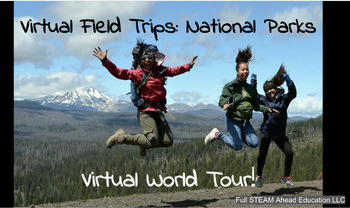
Virtual Field Trips: National Parks - Full STEAM Ahead Edu
Want to take students on a virtual field trip around the world?? This slidedeck provides images of beautiful National Park locations, vetted links to videos and information about each National Park, and question stems to guide conversation and discussion! - Suggested instructions with question stems to guide discussion- 7 locations all around the world- 4 location ideas to provide opportunities for student researchPerfect for Friday Fun Days, lesson exploration and extension, Earth Science and L
Subjects:
Grades:
5th - 12th
Types:
NGSS:
MS-ESS2-3
, HS-ESS2-1
, HS-LS2-3
, HS-LS2-7
, MS-LS2-2
...
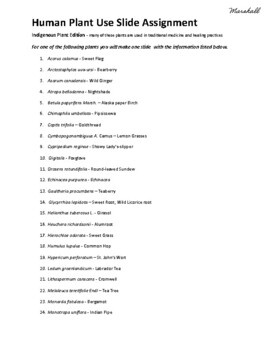
Human Plant Use Assignment
This assignment sheet will coordinate with a Google Slide presentation where each student is responsible for one slide. Students will investigate the anthropogenic use of a plant from the list provided. This task focuses on Indigenous plants. This resource also includes a marking scheme with which the teacher can use to assess the mini-presentations. (This is a Google Slides class presentation).
Subjects:
Grades:
11th
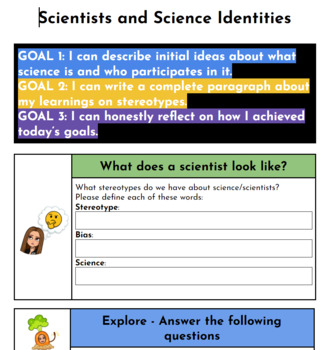
Scientists and Science Identities
In this assignment, students learn about stereotypes in the STEM field and reflect on what a scientist means to them. Students research a scientist that they believe connects to their identity in some way and they write a summary about that scientist. This hyperdoc guides them through reflection questions, examples of scientists that reflect the identities in my classroom, instructions for research, sentence stems for their summary paragraph and my own example.
Subjects:
Grades:
7th - 12th
Showing 1-24 of 27 results





